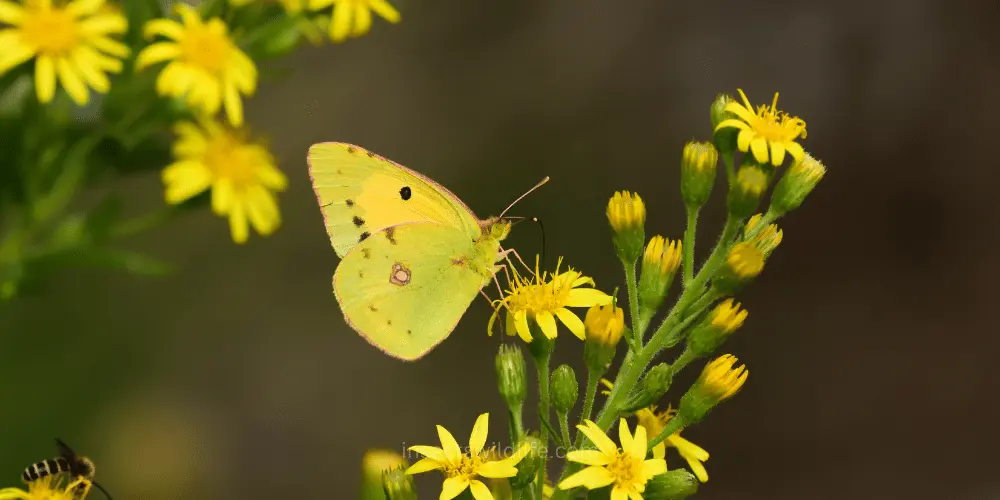Butterflies have long captured our imagination with their beauty and metamorphosis. Of the estimated 17,500 butterfly species worldwide, many showcase vibrant yellow wings that seem to glow under the sun’s rays. In gardens, grasslands, and forests across the globe, these delicate yellow butterflies flutter gracefully from flower to flower.
But where can you find yellow butterflies in the wild and what makes them yellow? Read on to learn more about yellow butterfly symbolism, traits, migration patterns, top viewing locations, and how to attract them to your yard.
Yellow butterflies symbolize joy, hope, and transformation across many cultures. Their brightness and vibrancy evoke happiness and optimism for the future. In Mexico, yellow butterflies represent the returning souls of deceased loved ones for the Day of the Dead. In Christianity, their rebirth from a caterpillar is seen as a metaphor for resurrection.
Common Yellow Butterfly Species and Traits
Hundreds of butterfly species exhibit yellow coloring either partially or completely. Here are some of the most frequently seen:
- Brimstone Butterfly: One of the first butterflies to emerge in spring, it has bright yellow wings edged in green with white spots on the undersides. Native to Europe, Asia, and North Africa.
- Cloudless Sulfur: A swift tropical species found across the Americas. Males are vivid yellow above with yellow-green undersides while females have yellow upper wings with mottled yellow-brown undersides.
- Sleepy Orange: Named for its slow, floating flight. Widespread across North America with reddish-orange wings outlined in brown and circular eyespots to deter predators.
- Dainty Sulfur: A small sulfur species under 2 inches found in North America. Males are lemon-yellow above with gray undersides while females have yellow upper wings with yellow-green undersides.
- Large Yellow Underwing: A stout, triangle-shaped moth native to Europe and Asia. At rest, its bright yellow hindwings are hidden. When startled, it flashes them as a warning.
Yellow pigments like pterins and flavonoids in the scales on butterfly wings help provide camouflage among sunlit flowers. Air bubbles within the scales also scatter light to enhance the vivid yellow tones.
In addition to their colorful wings, all butterflies share common traits like six legs, a proboscis to drink nectar, antennae, and a three-stage life cycle (egg, caterpillar, pupa).
Yellow Butterfly Migration Patterns
Many temperate yellow butterfly species migrate south to warmer climates for the winter. Some well-known migrations include:
- Monarch Butterflies: One of the most spectacular migrations that can exceed 2,500 miles from Canada and the U.S. to overwintering grounds in central Mexico’s oyamel fir forests. Their journey takes several generations to complete.
- Painted Lady Butterflies: Known to travel from tropical Africa to as far north as Alaska. In North America, they migrate from Mexico through the U.S. and into Canada in spring and back south in fall.
- Cloudless Sulfur: Tropical species that migrate northward each summer, following the bloom of nectar flowers up through the southern, central, and eastern U.S. In the fall, they head back to tropical areas like Central America and Southern Florida.
Tracking blooming flowers and ideal weather conditions, these migrations showcase the yellow butterflies’ astounding endurance and navigational ability. Some migrate solo while others cluster together by the thousands.
Top Spots to See Yellow Butterflies
Here are some top spots in the U.S. to potentially glimpse yellow butterflies in action:
Public Gardens and Conservatories
Carefully cultivated public gardens often act as oases that attract a variety of butterfly species. Some top picks include:
- Denver Botanic Gardens (Colorado)
- Missouri Botanical Garden (St. Louis, Missouri)
- University of California Botanical Garden (Berkeley, California)
- United States Botanic Garden (Washington D.C.)
Nature Reserves and Parks
Natural areas rich in native plants and flowers create an ideal habitat for butterflies. Popular reserves include:
- Prairie Passage Butterfly Reserve (Illinois): Located along the famous Monarch migration route.
- Rock Creek Park (Washington D.C.): Over 240 butterfly species were recorded along its trails.
- Point Pelee National Park (Canada): A major Monarch gathering spot before crossing Lake Erie.
Backyards
Don’t overlook your backyard! Planting a butterfly garden with native flowers tailored to your region will draw in local species.
Creating a Butterfly-Friendly Yard
You can easily transform your yard into a butterfly paradise by following these tips:
- Plant Native Host and Nectar Plants: Choose plants like milkweed and lantana that provide food for caterpillars and energy-rich nectar for adults.
- Include a Variety of Flower Colors/Types: Different flower shapes give butterflies ample landing pads. Choose plants that bloom in succession from spring through fall.
- Provide Open Areas and Shelter: Butterflies need sun for basking but also shade and shelter from strong winds. Leave some areas of soil bare for basking.
- Supply Water Sources: A shallow bird bath, water fountain, or garden pond gives butterflies needed hydration. Place flat rocks in the water for perching.
- Avoid Pesticides: Chemicals and insecticides are highly toxic to all life stages of butterflies. Opt for natural pest control methods instead.
- Limit Disturbance: Allow some weeds and dead leaves for caterpillar food and shelter. Leave wild areas of the yard overgrown.
By creating a welcoming haven filled with bright flowers, you’ll soon notice yellow wings fluttering about your landscape. Observing the beauty of yellow butterflies up close evokes a childlike sense of wonder. Their vibrant coloration and delicate grace never fail to lift our spirits and remind us of nature’s boundless capacity for joy.


